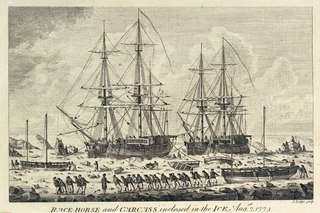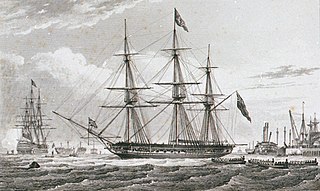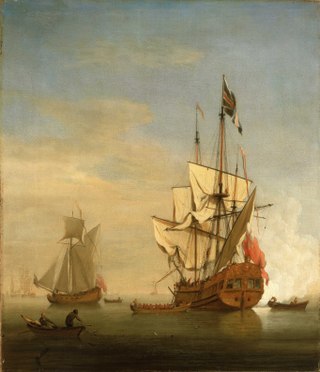
HMY Fubbs was a Royal Yacht of the Royal Navy of the Kingdom of Great Britain. She was scrapped towards the end of the eighteenth century after having been in service for 99 years.

HMY Royal Caroline was a ship-rigged royal yacht. She was ordered in 1749 to replace HMY Carolina as Britain's principal royal yacht. She was built at Deptford Dockyard under the supervision of Master Shipwright John Hollond to a design by Surveyor of the Navy Joseph Allin. She was launched on 29 January 1750 and was broken up 70 years later, in 1820.

HMS Lenox was a 70-gun third rate built at Deptford Dockyard in 1677/78. She was in active commission for the War of English Succession fighting in the Battles of Beachy Head and Barfleur. She was rebuilt in 1699. Again in active commission for the War of Spanish Succession fighting in the Capture of Gibraltar and the Battle of Velez Malaga. She followed this with the Battle off Passero. She was rebuilt again in 1721. She was active in the War with Spain, capturing the Princesa then serving in Home Waters, the Mediterranean and finally the West Indies. She was in action off Havana in 1745. She returned home and was placed in Ordinary. She was finally sunk as a breakwater at Sheerness in 1756.
HMS Burford was a 70-gun third rate ship of the line built at Woolwich Dockyard in 1677/79 as part of the Thirty Ships Programme of 1677. She fought in the War of the English Succession, including the Battle of Barfleur, before being rebuilt at Deptford in 1699, remaining as a 70-gun third rate. During the War of Spanish Succession she was mostly in the Mediterranean fleet and fought at the capture of Gibraltar and the Battle of Málaga in 1704 before being extensively repaired between 1710 and 1712 at Portsmouth Dockyard. Burford served in the Baltic in 1715 and 1717 before returning to the Mediterranean to fight the Spanish at the Battle of Cape Passaro in 1718. She was wrecked on the Italian coast in a storm on 14 February 1719.

HMS Carcass was an Infernal-class bomb vessel of the Royal Navy, later refitted as a survey vessel. A young Horatio Nelson served aboard her as a midshipman on an expedition to the Arctic in 1773.

HMS Hind was a 28-gun sixth-rate frigate of the Royal Navy.
HMS Triton was a modified Mermaid-class sixth-rate 28-gun frigate of the Royal Navy.

HMY Mary, was an English royal yacht of the Royal Navy. She was built by master shipwright Phineas Pett and launched at Chatham Dockyard in 1677. She had eight guns and measured She now measured 155 bm. She experienced a very long career of naval service spanning 139 years, having been rebuilt in 1727.

HMS Royal Sovereign was one of the royal yachts of King George III. She was the largest of his yachts and served from 1804 until she was broken up in 1849.

HMS Hyaena was a 24-gun Porcupine-class post-ship of the Royal Navy launched in 1778. The French captured her in 1793, took her into service as Hyène, and then sold her. She became a privateer that the British captured in 1797. The Royal Navy took her back into service as Hyaena and she continued to serve until the Navy sold her in 1802. The shipowner Daniel Bennett purchased her and renamed her Recovery. She made seven voyages as a whaler in the British southern whale fishery and was broken up 1813.

HMS Peregrine Galley was a 20-gun sixth-rate ship of the Royal Navy, built in 1699-1700 at Sheerness Dockyard by Master Shipwright William Lee to a design by Rear-Admiral the Marquis of Carmarthen. She was generally employed as a Royal yacht and in 1716 she was officially renamed HMS Carolina and converted to a permanent Royal yacht. In May 1733 she was rebuilt by Richard Storey at Deptford Dockyard as the Royal yacht and again renamed, this time as Royal Caroline. In 1739 she ceased to be the Royal yacht and resumed her classification as a Sixth Rate. In 1749 a new Royal Caroline was built to replace her. She reverted to being a naval sloop under the name HMS Peregrine and served until her loss on or about 28 December 1761.
HMS Saudadoes was built by Anthony Deane after his transfer to Portsmouth Dockyard as the Master Shipwright. She was a smaller version of the Greyhound design. Initially she was a 8/6-gun sixth rate vessel. She was rebuilt in 1673 as a standard 16-gun vessel. She was commissioned in November 1669 then taken in hand at Deptford for her rebuild. She spent the majority of her career in Home Waters, participating in the Battle of Bantry Bay and the Battle of Barfleur. She went to the Mediterranean for a year in 1694. Her final service was in the Channel where she was captured by two French privateers and burnt in February 1696.
HMS Queenborough was a member of the standardize 20-gun sixth rates built at the end of the 17th century. The bulk of her career was spent in Home Waters. During her time in the English Channel she took three French privateers. She went to the Leeward Islands where two of her Captains died before returning home. She was sold in 1719.
HMS Seaford was a member of the standardize 20-gun sixth rates built at the end of the 17th Century. After she was commissioned she had a very varied career, starting in the Mediterranean then the Irish Sea, then to Newfoundland, the North Sea followed by a great repair then to the Leeward Islands. She was dismantled in 1722 and rebuilt as a bomb vessel in 1727 than a 20-gun sixth rate in 1728. She served in the West Indies, America and the Mediterranean. She was finally broken in 1740.
HMS Nightingale was a development of the standardize 20-gun sixth rates and were built at the beginning of the 18th Century. After she was captured by French privateer galleys in 1707 then recaptured four months later. She was renamed HMS Fox and continued service until she was rebuilt at Deptford. Her breaking was completed in January 1738.
HMS Sheerness was a fifth rate built under the 1689 programme built at Sheerness Dockyard. Her guns were listed under old terms for guns as demi-culverines, sakers and minions. After commissioning she spent her career in Home Waters, North America, Mediterranean and the West Indies. She was reduced to a 20-gun sixth rate in 1717 then rebuilt as a Modified 1719 Establishment sixth rate in 1731. She was sold in 1744.
HMS Shoreham was a 32-gun fifth rate vessel built under contract at Shoreham in 1693/94. During the War of the English Succession she was involved in the unsuccessful operation at Camaret Bay. At the end of the war she helped take half a French convoy off Ireland. She then deployed to North America and the West Indies. She was rebuilt as a 20-gun sixth rate to the 1719 Establishment in 1719/21. She served in the Baltic as a bomb vessel then reverted to a sixth rate. She participated in operations in the West Indies during the initial years of the War of Austrian Succession before being sold in 1744.
HMS Lyme was a 32-gun fifth rate built by Mr. Flint of Plymouth in 1694/95. She spent her career on counter piracy patrols and trade protection duties in Home Waters, the Mediterranean and in North America and the West Indies. She was rebuilt to the 1719 Establishment as a sixth rate in 1720/21. Her breaking was completed in January 1739.
HMS Poole was a 32-gun fifth rate built by Joseph Nye & George Moore of East Cowes on the Isle of Wight in 1695/96. She spent the first part of her career on trade protection and counter piracy patrols. After 1719 she was converted to a fireship. She was finally sunk as a breakwater at Harwich in July 1737.
HMS Bridgewater was a 32-gun fifth rate built at Sheerness Dockyard in 1697/98.










